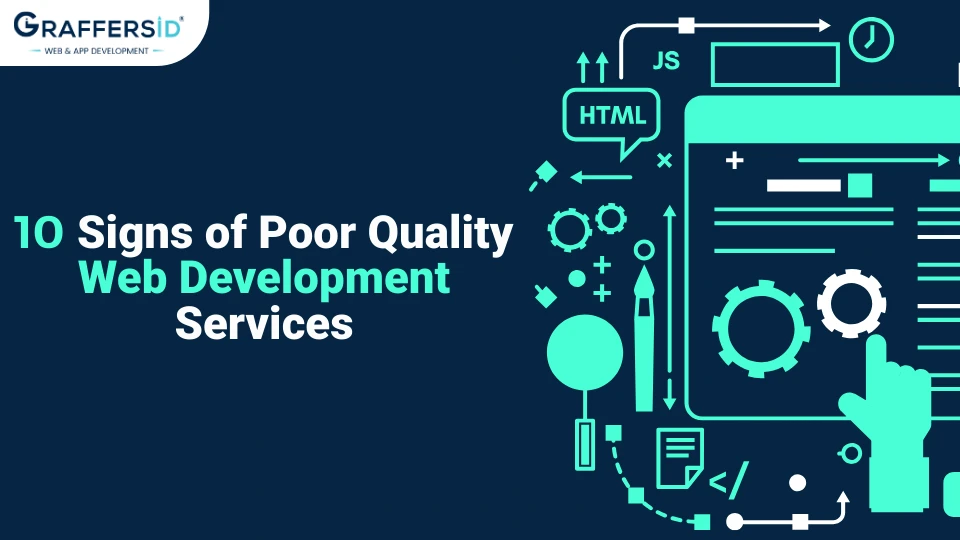In 2024 and beyond that, having a high-quality website is crucial for businesses to succeed online. However, not all web development services deliver the same level of quality. Poorly developed websites can lead to various issues that negatively impact user experience, search engine rankings, and overall business performance. In this article, we’ll explore 10 signs that indicate poor quality in web development services, helping you make informed decisions when choosing a web development partner.
What is Web Development?
Web development involves creating and maintaining websites. It covers everything from static pages to complex web applications, e-commerce platforms, and social networking sites. Web development brings websites to life, making them accessible and functional.
Importance of Web Development in Today’s Digital World
In our digital age, web development is more critical than ever. Websites are essential for businesses, organizations, and individuals to establish their online presence, reach a global audience, and provide information and services. Without web development, the internet as we know it wouldn’t exist.
The Basics of Web Development
Frontend Development
Frontend development focuses on the client side of websites – what users see and interact with. It involves:
- HTML (HyperText Markup Language): The backbone of any web page, providing its structure.
- CSS (Cascading Style Sheets): Responsible for the visual styling and layout.
- JavaScript: Adds interactivity and dynamic features.
Backend Development
Backend development deals with the server side of websites, which users don’t see. It includes:
- Servers: Machines that host websites and handle requests.
- Databases: Store and manage data for websites.
- Server-Side Languages: Python, PHP, Ruby, and Node.js process data and perform backend logic.
10 Signs of Poor Quality in Web Development Services

Quality web development is essential for creating user-friendly, responsive, and secure websites that meet modern standards. A well-developed website attracts visitors, keeps them engaged, and encourages conversions.
1. Lack of Responsive Design
One of the most evident signs of poor web development is the lack of responsive design. A website that doesn’t adapt to different screen sizes and devices leads to a frustrating user experience, especially on mobile devices. Users expect seamless navigation and readability across all platforms, and a non-responsive website fails to deliver that.
2. Slow Loading Speed
Another red flag is a slow-loading website. In today’s fast-paced world, users have little patience for sites that take ages to load. Slow loading speeds not only deter visitors but also hurt search engine rankings, as search engines prioritize fast-loading websites.
3. Outdated Technology
Using outdated technology in web development can severely limit a website’s functionality and performance. Older frameworks, plugins, and coding practices may lead to compatibility issues, security vulnerabilities, and overall poor user experience.
4. Poor Mobile Optimization
Mobile optimization is crucial with a significant portion of internet traffic coming from mobile devices. Poorly optimized websites for mobile users result in reduced visibility, lower rankings on mobile searches, and missed opportunities for engagement and conversions.
5. Inadequate Security Measures
Web development services that overlook security measures put websites at risk of data breaches, hacks, and malware attacks. Implementing robust security protocols, SSL certificates, and regular updates are essential for safeguarding sensitive information and maintaining trust with users.
6. Lack of Scalability
A well-developed website should be scalable to accommodate future growth and changes. Poorly developed websites may struggle to handle increased traffic, new features, or expanding content, leading to performance issues and downtime.
7. Unintuitive Navigation
Complex or confusing navigation structures hinder user engagement and conversion rates. Visitors should be able to find what they’re looking for quickly and easily. Intuitive navigation enhances user experience and encourages users to explore more pages on the website.
8. Broken Links and Errors
Broken links, 404 errors, and other technical issues create a negative impression on visitors and harm SEO efforts. Regular monitoring, maintenance, and fixing of broken links are essential for a seamless user experience and search engine visibility.
9. Lack of Support and Maintenance
Web development doesn’t end with the launch of a website. Ongoing support, maintenance, and updates are crucial for keeping the site secure, functional, and up-to-date with industry standards. Poor-quality web development services often neglect these essential aspects.
10. Poor Content Management System (CMS)
A subpar CMS can make it difficult to update and manage your website’s content. If adding new pages, editing existing content, or integrating multimedia is cumbersome, it’s a sign that the web development service did not prioritize ease of use. A good CMS should be intuitive, flexible, and allow for seamless updates without needing extensive technical knowledge.
Why is Identifying Low-Quality Web Development Important?
A. Impact on User Experience
Low-quality web development can result in a poor user experience, leading to decreased user engagement and satisfaction.
B. SEO Implications
Search engines prioritize websites with high-quality content and user experience. Low-quality web development can harm search engine rankings.
C. Business Consequences
For businesses, a poorly designed website can deter potential customers, lower conversion rates, and damage brand reputation.
How to Identify Low-Quality Web Development Work
A. Conduct a Visual Inspection
- Evaluate the overall design and aesthetics of the website.
- Check for consistency in branding elements such as logos, colors, and fonts.
- Ensure that the website is visually appealing and easy to navigate.
B. Test Performance Metrics
- Use tools like Google PageSpeed Insights to assess loading times and performance.
- Test the website on different devices and browsers to ensure compatibility and responsiveness.
- Check for broken links or errors using tools like Screaming Frog SEO Spider.
C. Review Code Quality
- Inspect the website’s code for readability, efficiency, and adherence to coding standards.
- Look for any deprecated or outdated code that could impact performance or security.
- Consider hiring a professional developer for a code review if necessary.
Steps to Avoid Low-Quality Web Development
A. Set Clear Requirements and Goals
Clearly define your requirements and goals for the website before starting the development process.
B. Choose a Reputable Web Development Partner
Research and choose a reputable web development agency or freelancer with a proven track record of delivering high-quality work.
C. Regular Testing and Maintenance
Regularly test the website for performance, security, and usability issues. Invest in ongoing maintenance to keep the website up to date.
Web Development Frameworks and Libraries
Before diving into specifics, let’s clarify the difference between frameworks and libraries. While both are essential components of web development, they serve distinct purposes.
Frameworks are comprehensive structures that provide a foundation for building applications. They often come with predefined code structures, libraries, and utilities to facilitate development tasks. Frameworks like Angular and Flutter offer structured environments for creating interactive user interfaces and single-page applications.
On the other hand, libraries are collections of reusable code modules or functions that developers can integrate into their projects as needed. Libraries such as jQuery, Bootstrap, and D3.js provide ready-made solutions for common tasks like DOM manipulation, styling, and data visualization.
1. React:
Known for its component-based architecture, React has revolutionized front-end development. Its virtual DOM and one-way data flow optimize performance, making it ideal for building dynamic interfaces. React’s ecosystem, including tools like Redux for state management and Next.js for server-side rendering, empowers developers to create scalable, SEO-friendly web applications.
2. Angular:
Developed and maintained by Google, Angular is a full-fledged framework that excels in building complex, feature-rich applications. Its two-way data binding, dependency injection, and powerful CLI streamline development workflows. Angular Material provides a rich set of UI components, ensuring consistent designs across projects.
3. Vue.js:
Vue.js strikes a balance between simplicity and versatility. Its reactive data binding, virtual DOM, and Vue Router for routing make it a favorite among developers. Vue’s ecosystem includes Vuex for state management and Nuxt.js for server-side rendering, enhancing its capabilities for building modern web applications.
4. jQuery:
Despite the rise of modern frameworks, jQuery remains relevant for its simplicity and cross-browser compatibility. It simplifies DOM manipulation, event handling, and AJAX requests, making it valuable for enhancing legacy applications or quick prototyping.
5. Bootstrap:
As a front-end framework, Bootstrap offers a robust grid system, responsive components, and pre-styled UI elements. It accelerates development by providing a cohesive design language and ensuring mobile-friendly layouts out of the box.
6. D3.js:
For data visualization tasks, D3.js stands out with its powerful capabilities. It enables developers to create interactive and dynamic charts, graphs, and maps using SVG, HTML, and CSS. D3’s flexibility and extensive documentation make it a go-to choice for visualizing complex data sets.
The beauty of web development lies in its diversity of tools and approaches. Whether opting for a comprehensive framework or leveraging specific libraries, developers have the freedom to choose based on project requirements, team expertise, and scalability goals.
By embracing the right frameworks and libraries, developers unlock the innovation potential. They can focus on crafting engaging user experiences, optimizing performance, and staying agile in a rapidly changing digital landscape.
In conclusion, the quality of web development services significantly impacts a website’s performance, user experience, and overall success. Businesses must prioritize partnering with reputable, experienced, and quality-focused web development agencies to ensure their online presence meets modern standards and delivers optimal results.
Hire The Best Web Development Company – GraffersID
Ready to transform your digital vision into reality? Partner with GraffersID, the premier web development company known for delivering top-notch, innovative solutions tailored to your needs. Our expert team excels in creating user-friendly, high-performance websites that drive engagement and growth. Don’t settle for average—hire the best. Contact GraffersID today and elevate your web presence to new heights!
FAQs
Q1: How can I assess the quality of a web development service before hiring them?
A1: Look for portfolios, client testimonials, and industry certifications, and ask about their development process and technologies used.
Q2: What role does SEO play in web development quality?
A2: SEO-friendly web development practices improve website visibility, ranking, and organic traffic, contributing to overall online success.
Q3: Why is mobile optimization essential for websites?
A3: Mobile optimization ensures that websites perform well on smartphones and tablets, catering to the growing mobile user base.
Q4: How often should I update my website after development?
A4: Regular updates, maintenance, and content additions keep websites fresh, secure, and relevant to users and search engines.
Q5: What should I do if I discover issues with my current website’s development quality?
A5: Consult with experienced web developers or agencies to assess and address any issues, ensuring optimal performance and user experience.




